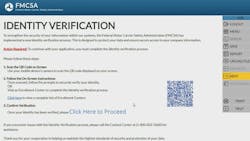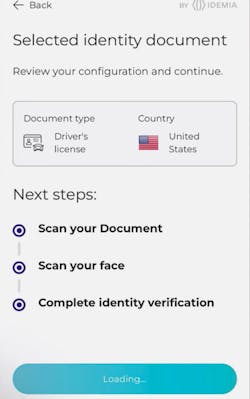Key takeaways:
- FMCSA now requires identity verification for new registrants in URS.
- The agency plans to require all registrants to verify their identities once its new registration system rolls out.
- The new registration system could go live later this year.
The Federal Motor Carrier Safety Administration is taking major strides in 2025 to improve its registration processes and reduce fraud. The agency is implementing an identity verification process and developing a new, unified registration platform.
“Fraud is coming at this industry from every angle,” Kenneth Riddle, director of FMCSA’s Office of Registration and Safety Information, said during a registration update webinar hosted by the Truckload Carriers Association. “It doesn’t matter whether it’s the insurance lane, the process agent lane, a carrier, a broker. Fraud is rampant.”
The Unified Registration System (URS) was FMCSA’s decades-long attempt to develop a unified online registration system. The agency suspended its work on URS in 2017 during early rollout; the system today only supports first-time applicants. Existing applicants have been stuck with older, separate forms and platforms to manage their information.
Soon, FMCSA will implement a new system—which it now calls Motus—to provide a smooth, intuitive platform for new and existing applicants. The agency is also implementing a new identity verification process to crack down on fraud.
See also: Three fleets awarded FleetOwner Private Fleet of the Year honors
“I’m very excited about the new system. It can’t come fast enough,” Riddle said. “We want to get it right, and we want it to be intuitive—not like the systems we have today.”
New identity verification
FMCSA has added a new identity verification process in URS, requiring all new applicants to prove their identity before receiving a USDOT Number. The process went live on URS in early April.
In order to verify their identity, registrants need two things: an appropriate identifying document (e.g., driver’s license, passport) and an electronic device for facial recognition.
How it works
The verification then takes place near the end of the URS registration process before payment. Registrants will scan a QR code in URS to go to a platform hosted by IDEMIA. There, the registrant scans their identifying document and scans their face to complete their identity verification. IDEMIA checks the validity of the documents and ensures the face matches the document.
To execute the program, FMCSA is contracting IDEMIA, the same company that provides the technology for all TSA checkpoints.
“We are using the exact same company, the exact same software,” Riddle said. “They are well-known and they’re good at what they do.”
Identity verification's effectiveness so far
The identity verification program has been operational for over 30 days and already automatically blocked several illegitimate applications.
In the first 16 days, FMCSA counted 3,476 unique users that completed the identity verification process. Of those, 3,392 users passed and 84 users failed—a 97.6% pass rate.
However, FMCSA also counted 21,176 sessions, which was every time someone opened the QR code to IDEMIA’s process. Of those total sessions, 7,265 passed and 13,911 either failed or did not finish the process—a 34.3% pass rate. The passing sessions outnumbered the passing users because some users (like FMCSA’s help staff) accessed the process multiple times.
A significant number of the failed sessions may have been bots, Riddle said. He called the numbers “disturbing” and IDEMIA’s ability to block invalid sessions “impressive.”
What’s next for identity verification?
FMCSA wants to expand its identity verification requirements to all registered parties. Once the agency launches its new registration system, it will require existing registrants to also verify their identities.
“We know there are individuals in our system that shouldn’t be there," Riddle said. "We’ve got to weed them out ... Today, it’s new applicants only. When we roll out the new system, it will be all existing registrants that go through identity verification."
Carriers only need to verify their identity once, as the process will be tied to their login.gov credentials. However, Riddle warned, FMCSA might want to re-verify specific carriers’ identities in the future.
FMCSA’s plans for the new registration system
Carriers today have to access five different platforms—MCMIS, DataQs, L&I, URS, and Portal—for event handling, lifecycle management, registration, and authentication. The systems use different platforms that might have conflicting information for the same carrier.
See also: A peek at FMCSA’s new online registration system
“We have a lot of systems at FMCSA, and they don’t really play well together,” Riddle said. “And none of them are really user-friendly.”
To solve the issue, FMCSA is working toward one system and one database to handle everything. The platform used to be called the FMCSA Registration System, or FRS, and is now called Motus—a Latin term for motion.
The agency does not have an official launch date, but Riddle said that they plan to launch in 2025. The rollout will come in two main phases, with continuous additional development afterwards.
For the first part of the rollout, FMCSA will allow supporting companies to create profiles on Motus: transportation service providers, blanket companies, and financial responsibility filers. Then, the platform will launch for all users with only limited functionality.
Every registered customer will have a user account on Motus. Every customer will also have to undergo identity verification. Beyond identity verification, the platform will have two other changes to carriers’ information:
- Principal place of business verification will have a new, improved process as part of business verification.
- Suffixes will appear at the end of a carrier’s USDOT number to reflect their registration type.
Riddle also said that FMCSA will not make changes it had previously announced. These changes may still take place in future releases but won’t be included in the first release:
- MC/FF Docket Numbers will not be eliminated.
- Safety Registration will not be implemented.
- BOC-3 filing will not change.
The agency plans to continually improve the platform and develop additional functions after the initial launch.
“Everything that we want will not be there,” Riddle said. “But it will be a heck of a lot better than we have today.”
About the Author
Jeremy Wolfe
Editor
Editor Jeremy Wolfe joined the FleetOwner team in February 2024. He graduated from the University of Wisconsin-Stevens Point with majors in English and Philosophy. He previously served as Editor for Endeavor Business Media's Water Group publications.



